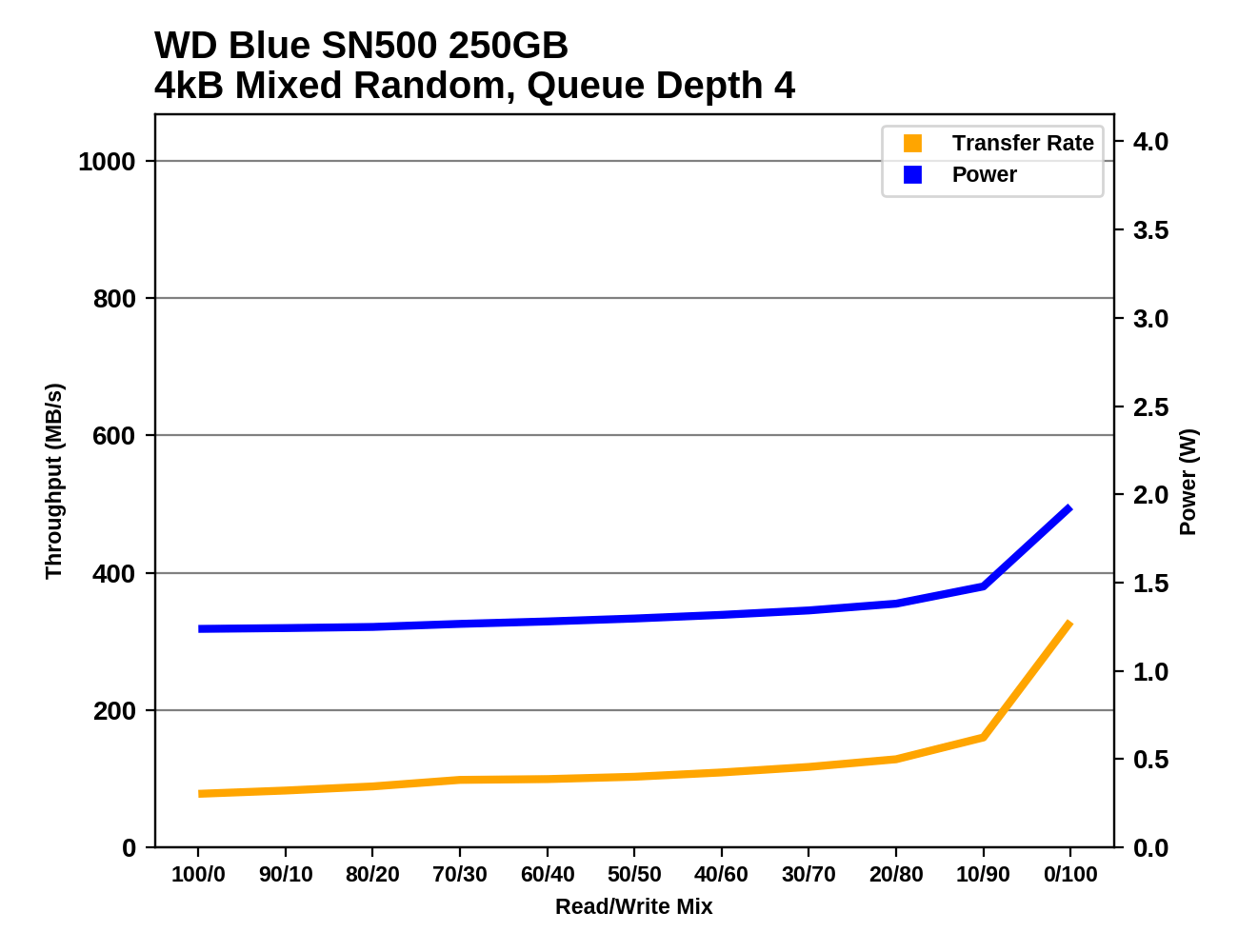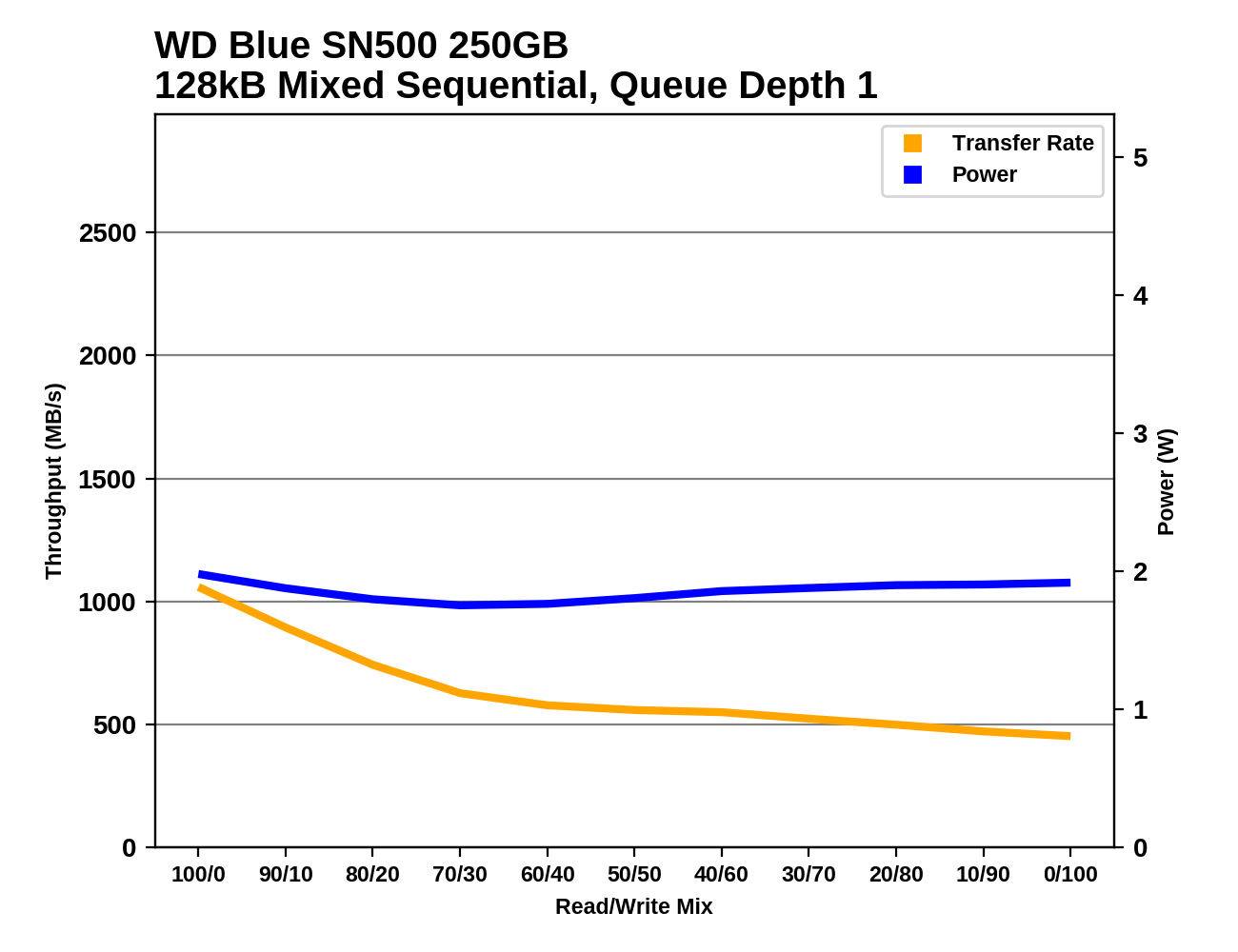The Western Digital WD Blue SN500 SSD Review: Moving The Mainstream To NVMe
by Billy Tallis on April 19, 2019 9:30 AM ESTMixed Random Performance
Our test of mixed random reads and writes covers mixes varying from pure reads to pure writes at 10% increments. Each mix is tested for up to 1 minute or 32GB of data transferred. The test is conducted with a queue depth of 4, and is limited to a 64GB span of the drive. In between each mix, the drive is given idle time of up to one minute so that the overall duty cycle is 50%.

The WD Blue SN500 is very slightly slower on the mixed 4kB random IO test than the larger WD Blue SATA SSD, and is significantly slower than the various high-end NVMe models. The other two entry-level NVMe drives are even slower than the SN500.
 |
|||||||||
| Power Efficiency in MB/s/W | Average Power in W | ||||||||
Despite relatively low performance, the WD Blue SN500's efficiency score on the mixed random IO test is a bit above average due to it drawing far less power than most of the high-end NVMe SSDs or even the SATA drives that outperformed it.
 |
|||||||||
The WD Blue SN500's performance on the mixed random IO test shows a fairly normal slow growth in performance as the workload shifts to be more write-heavy. At the very end, the ability to combine writes without any read operations getting in the way leads to a jump in performance even though the SLC write cache is full during almost all of this test.
Mixed Sequential Performance
Our test of mixed sequential reads and writes differs from the mixed random I/O test by performing 128kB sequential accesses rather than 4kB accesses at random locations, and the sequential test is conducted at queue depth 1. The range of mixes tested is the same, and the timing and limits on data transfers are also the same as above.

The WD Blue SN500 cannot compete with most of the high-end NVMe SSDs on the mixed sequential IO performance test, but it offers decent overall performance that is a bit higher than some of the other low-end NVMe drives and is a clear step up from any of the SATA drives.
 |
|||||||||
| Power Efficiency in MB/s/W | Average Power in W | ||||||||
The power efficiency of the SN500 on this test is quite a bit lower than what the 1TB WD Black SN750 delivered, but among other 256GB-class drives the SN500's efficiency is top-tier.
 |
|||||||||
As writes are added to the workload, the WD Blue SN500's performance drops—quickly at first, but then almost leveling out as the drive approaches SATA speeds. By the end of the test when the workload is pure writes, the SN500 is performing below theoretical SATA limits, but beats any actual 256GB-class SATA drive we have on hand.










50 Comments
View All Comments
DyneCorp - Sunday, April 21, 2019 - link
You got the EX920 512GB on sale. That's not the typical retail price, and the SN500 is already sitting at $65 retail.You understand the price of this drive will go down? As they always do after initial release? And when the prices of NAND skyrocket again, the SN500 will have a major advantage?
For the majority of consumers, the SN500 is a viable option.
airider - Friday, April 19, 2019 - link
This is WD clearing out their inventory while making way for the higher capacity/performance versions coming out shortly. Don't expect to see this product anymore by the end of 2019.flyingpants265 - Saturday, April 20, 2019 - link
Wait, so it's not QLC nand? That's great. It states 300TB write endurance, compared to the 100TB of the 500gb Crucial P1, for the same price. Goodbye, QLC! For now..DyneCorp - Sunday, April 21, 2019 - link
For consumers, the endurance rating matters none. You'll never chew through 100TB of endurance, especially under consumer workloads. The massive SLC cache buffers utilized in the P1 and 660p in addition to smart caching algorithms increase endurance substantially. Also, the DRAM buffer in addition to smart controller firmware effectively mitigate write amplification by several factors. You'll never chew through the endurance of the P1 or the 660p, period.Endurance ratings are meaningless under consumer workloads. SSDs far outlast their given endurance ratings.
flyingpants265 - Wednesday, April 24, 2019 - link
Well, hopefully. Because just to download install one game (hitman 2) requires about 240GB of writes. If I do that 3 times, that's 1% of my drive's life gone.flyingpants265 - Wednesday, April 24, 2019 - link
Uh, 4 times.DyneCorp - Wednesday, April 24, 2019 - link
This is incorrect. 240GB of writes does not equal 240GB of endurance lost, especially if they are sequential writes because:1.) The controller can reduce write amplification by intelligently shifting data around
2.) Sequential writes to the SLC cache increase endurance significantly
3.) Folding blocks from the pSLC cache to QLC actually increases endurance
DyneCorp - Wednesday, April 24, 2019 - link
By the way, this is evidenced by the ADATA SU800. It has a massive dynamic SLC cache buffer and older Micron 32-layer 384-Gbit NAND and still carries the highest endurance rating on the market.willis936 - Saturday, April 20, 2019 - link
I'm surprised there isn't a significant difference in idle power consumption or drive-side efficiency for a DRAMless NVMe drive. This is a pretty nice piece of hardware, regardless of price.DyneCorp - Saturday, April 20, 2019 - link
Thanks for the review, Billy! I really appreciate your work; you always do an excellent job and I appreciate you taking time out of your life to throw these reviews up.Without the DRAM buffer, how do you think write amplification is affected? Obviously endurance is actually quite high (in SU800 territory) and performance is quite high. This is especially interesting considering how small the SLC cache buffer is.
Do you think WD has effectively mitigated negative endurance impact through firmware?